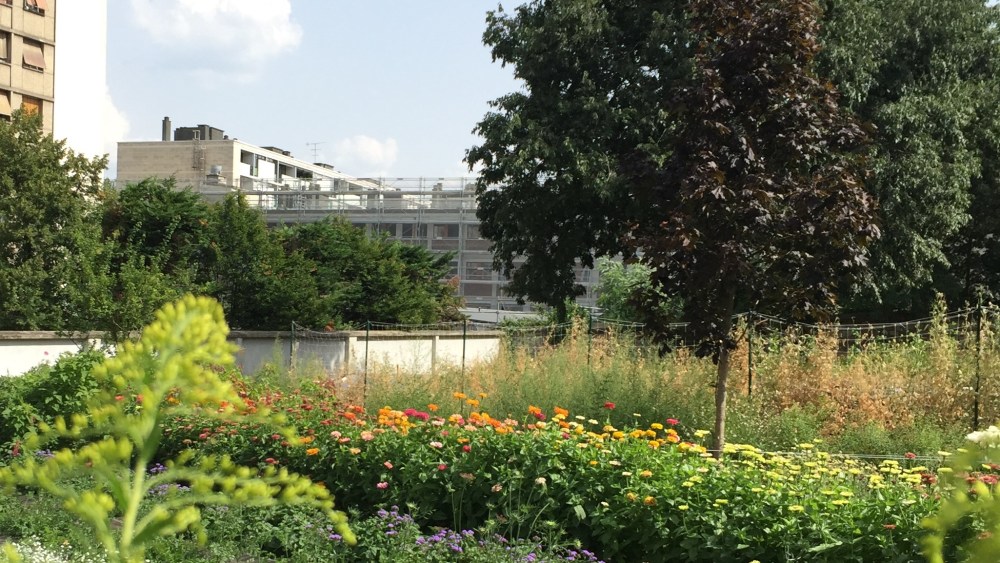It is among Paris’ blooming mysteries, nestled in the gritty sprawl of the French capital’s 20th arrondissement. To reach the location on the edge of town is an odyssey. Travel to 40 Rue du Télégraphe, then pass through an entryway of Belleville Cemetery. A walk through its gravestones leads to an almost hidden door in a far wall.
Step through that, and it’s well worth the journey. An altered state awaits.
Purple. Red. Orange. Copious shades of green. These are engulfing along with smells coming from dahlias, carnations, gladiolas, poppies and peonies springing from the 12,920-square-foot urban flower farm at the foot of Belleville’s reservoir. Called Plein Air Paris this repurposed wasteland belongs to the city. It is run by Masami Charlotte Lavault, an urban farmer-florist, who is the face of La Récolte Parisienne, Flower by Kenzo’s latest fragrance nodding to a Paris harvest.
“It’s like an apartment — I pay rent, for water and electricity, except that there is no roof,” she explained of her garden, standing among its wafting plants. “Everything you see here passed through my hands. I built the greenhouses, the sheds.”
She’s chosen and planted as many species of flowering plants as possible for this farm, which today boasts 350 different varieties. It’s a far cry from conventional flower farms that are monoculture.
“Here, I try to do the opposite,” she continued, explaining the strategy helps visitors get an overview of flower farming and also keeps any insect invasion or disease from obliterating her entire crop.
Lavault was not initially a farmer. She first studied industrial design at the University of Applied Arts in Vienna and Central Saint Martins in London, before making that her vocation. But the métier disappointed.
“I did not see that my job would ultimately be staying in front of a computer, in offices all the time, designing objects that would be produced in millions of copies then destroyed six months later because they’re no longer fashionable,” said Lavault, adding she was afraid of how little thought went into material sourcing. “I said to myself: I didn’t study for 10 years to do that. Suddenly, I decided — overnight — to stop.”
In 2013, she went to work on organic farms, as far away as she could get from industrial design. A similarity remains, though.
“With earth, water, human energy and plant seeds there is a form of creation made,” Lavault said.
She trained in biodynamic market gardening in Morocco and the U.K.; in the use of effective micro-organisms in Okinawa, Japan, and in organic floriculture with American horticulturist Erin Benzakein, of Floret Flowers.
Masami Charlotte Lavault
Courtesy of Kenzo Parfums
Lavault’s agricultural practice aims to preserve resources. Her flowers are grown without pesticides, insecticides or chemical fertilizers. Instead, she uses biodynamics and effective micro-organisms for floriculture that is respectful of the environment.
“It’s creation with extra care,” said Lavault, who characterizes herself as “a little florist and a lot flower grower. It’s a rather contemporary mix.”
She caught the eye of Kenzo Parfums, the LVMH Moët Hennessy Louis Vuitton-owned brand, which named her the ambassador of its Flower La Récolte Parisienne eau de parfum. That is the latest addition to its Flower by Kenzo franchise whose storyline since launching in 2000 has been about a wild flower reenchanting a city.
Firmenich perfumer Dora Baghriche used noninvasive Nature Print headspace technology to capture molecules around the dahlias bon odori growing in Lavault’s farm and added their aroma to the new fragrance formulation.
Her and Kenzo’s tie-in and similarities have many facets, including a focus on sustainability and the brand helping Levalut to develop an educational project. Both she and Kenzo are a cultural mix of Japanese and French.
Kenzo was drawn to her mission, which chimes with its own that is nature-steeped.
“It’s Kenzo for a more beautiful world,” reminded Alexandra Bellon Nouveau, global marketing manager for Flower by Kenzo.
Of Levalut’s garden, Armel Yver, sustainability director at LVMH fragrance brands, said: “It is quite linked to a form of poetry in the city.”

